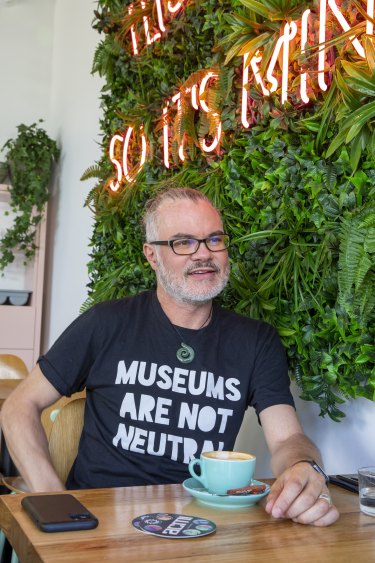
And Chan has already had several of those; when Sedgwick offered him the role in 2015, he was director of digital & emerging media at the Smithsonian’s Cooper Hewitt Design Museum in New York. He led the famed museum’s digital renewal, including the introduction of a special “pen” that allows museum visitors to engage with displays and “collect” information as they move around.

The house-smoked salmon kale salad.Credit:Wayne Taylor
The Pen, regarded as a game-changing overhaul of the museum experience, allowed visitors to save everything they see in the museum to take home and view or interact with later. Chan spent four years in New York, where he and his team garnered several awards for their work, and before that he was head of digital, social & emerging technologies at Sydney’s Powerhouse Museum (from where Cooper Hewitt headhunted him).
All the while, New Zealand-born Chan has worked as a DJ with legendary outfit Sub Bass Snarl, as a music journalist and a radio broadcaster. He also trained as a social worker. And published a music magazine. Quite the varied career.
“Well, what is a career these days,” he says. “In the ’90s I was doing a PhD in music subcultures, in the early days of the web, when I was heavily involved in the music scene in Sydney, around the sense of using spaces. Media, design, social change − those have been my three things and music’s been around that.”
He’s not a trained designer, but working in museums, he says, got him into designing spaces, and then designing technology in parallel. “I come from a sociological, ethnographic and anthropological approach to design. I’m interested in people-led design, how people use things, how things feel.”
Loading
At the freshly refurbished ACMI, which reopened last month, Chan’s influence in such design is obvious from the moment you enter; visitors are now offered a lens, a cardboard disc with an embedded chip that digitally collects information, links and more to expand the museum experience. Most of the exhibits now have a touch-point, which you tap your lens on and take the information home with you.
Unlike a history museum, ACMI, of course, focuses on existing technologies that visitors use in everyday life, at home.
“The lens is about making the link between that and going home. It opens up all that curatorial work about why we choose what is on show. That’s really important because museums need a bit of transparency about the choices we make,” Chan says. “It’s important for museums to be able to justify why we chose this and not that … rather than ‘this is the great stuff’.”
The lens, which looks − deliberately − like an old View-Master slide, allows “dialogue with the institution”.
“It’s the notion of using the museum almost like a pre-shopping experience; like when you go to a furniture store and look at things and then find [the items you want] on the web. This is using the museum to capture the things you’re interested in to remind yourself to watch later.”
Loading
Chan has always been fascinated with technology. His parents were early tech adopters and he knew his way around a Commodore 64 back in the early ’80s.
“I’ve always been interested in how technology changes our societies and how we work with that. I was into media production, I had a radio show, and then I got into publishing a music magazine … then the internet came along,” he says. He embraced it. “Before the internet I was on bulletin boards, back when you’d use a modem and your parents would wonder why the phone is always engaged.”
With the web, Chan relished the opportunity it presented for building networks and communities, as he had done with his analogue interests in music and publishing.

Chan says he is “interested in people-led design”.Credit:Wayne Taylor
“I’ve always been excited by the opportunities of the internet to be something that is more positive than I think it is now,” he says.
Part of the internet’s problem, he believes, is the speed at which technology has progressed. “It’s happened faster than we can adapt. It’s why museums interest me. Museums are about the sense of being able to see change by looking back through what’s collected.”
One of the challenges for institutions is preservation of technology-reliant objects and media.
“How do we preserve things like social media, or video games? What does that mean? How do we preserve the experience of playing video games? It’s not the game, it’s not the software. There is no canonical way.”
ACMI is working with RMIT and Swinburne University of Technology on developing methods of video game and contemporary media preservation, and the concept of how such media can be preserved and presented in the future in ways that people will understand in 100 years.

Receipt for lunch at Code 21, Brunswick.
It’s one of dozens of ideas that fizz around Chan’s mind. We talk video games; he’s a big advocate (“I think there’s a deep cultural issue still about play”) and himself (“I’m currently working my way through Assassin’s Creed Valhalla. A colleague and I play our way through the big-name titles for a couple of weeks and then interview each other”). Talk also turns to the “experience economy”, the blurring of art experiences and theme park concepts, and Instagram-friendly art: “Walking through the [NGV] Triennial, it’s clear there are some spots set up for that. You have to now − it’s part of the market. I’d love if that was transparent and overt; that might create more criticality around awareness of experience”. Then there’s the fact that he’s kept track of every song he’s listened to in the past 16 years, along with the GPS co-ordinates of where he was when he listened.
“It’s become a bit of an obsession, but it’s a process … where I can look back and do, what did this life event affect how I listen to things? Did it change anything?” So far he has a database of around 310,000 songs. “Digital music afforded me the ability to count everything, but it lost something. What I’m trying to do is, see what was lost with digital, what can I gain for understanding how it affects my mood? When I’m cross, do I listen to different music?”
We also spend a lot of time comparing our favourite museums. Among Chan’s favourites are The Gallery of Paleontology and Comparative Anatomy in Paris, a medical museum in Amsterdam and the Toyota Museum in Nagoya, Japan.
“For me, the ideal museum makes someone more interested in something, or interested in something they weren’t interested in at all.”
This idea plays into the ACMI lens concept, which Chan hopes will lead to less passive visits.
“We want people to spend time with us and extend that into their lives. A day out should affect your life,” he says. “Ideally, great art should affect you.”
THE BILL PLEASE
Code 21, 2/21 Brunswick Road, Brunswick East. 8370 9078.
Mon-Fri 6.30am-2pm; Sat 7.30am-2pm; Sun 8am-2pm.
Kylie Northover is Spectrum Deputy Editor at The Age






 Add Category
Add Category